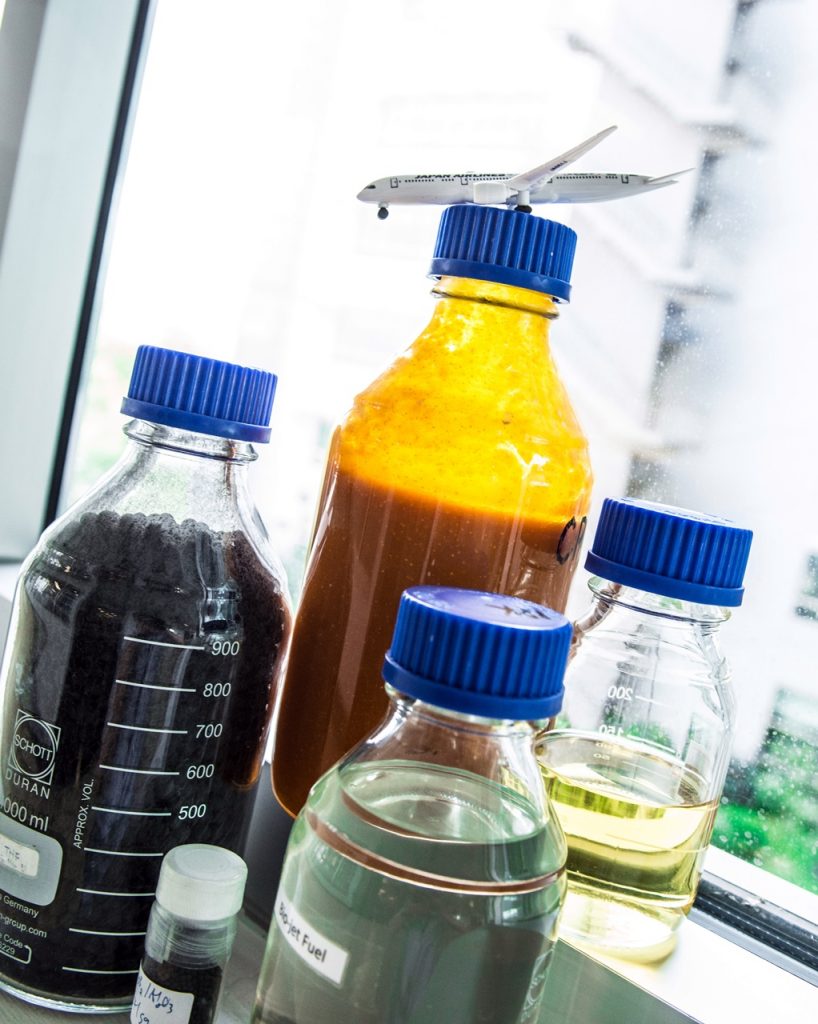Research
Sustainable aviation fuel
Our research focuses on the development of Sustainable Aviation Fuel (SAF) through pathways such as Hydroprocessed Esters and Fatty Acids (HEFA) and Alcohol-to-Jet (ATJ). We explore renewable feedstocks including vegetable oils, animal fats, and bioethanols from sugarcane and cassava. Our work spans from feedstock evaluation and process optimization to fuel property characterization, ensuring compliance with international standards like ASTM D7566. By studying feedstock variability, catalytic performance, and combustion behavior, we aim to produce high-quality SAF with properties complying with the regulations, supporting its safe and efficient integration into existing aviation infrastructure.
HEFA process

The Hydroprocessed Esters and Fatty Acids process (HEFA) is one of the approved methods for Sustainable Aviation Fuel (SAF) production by converting renewable feedstocks, such as vegetable oils, animal fats, and algae oils, into hydrocarbons. First, the feedstocks undergo hydroprocessing (hydrotreating), reacting with hydrogen at high temperatures and pressures to remove oxygen and adjust hydrocarbon chains by structural isomerization and cracking. These key reactions finally produce hydrocarbons similar to conventional jet fuel. The obtained SAF must meet the required standards (e.g. ASTM D7566) for fuel specification, making it a drop-in replacement for traditional aviation fuel with a high blending ratio up to 50%. Our background experiences in biohydrogenated diesel (BHD) and biojet technologies through hydrodeoxygenation (HDO) have extended to SAF production.
Alcohol to Jet process
The Alcohol-to-Jet (ATJ) process involves the conversion of alcohols, commonly ethanol or butanol, into SAF through catalytic dehydration, oligomerization, and hydrogenation. Initially, alcohols undergo dehydration to form olefins, which are then polymerized into higher molecular weight hydrocarbons. The resulting mixture is subjected to hydrogenation to saturate the compounds and remove oxygen. Finally, the paraffinic hydrocarbons are obtained and distilled to comply with the ASTM D7566 standard. In Thailand, bioethanols from sugarcane and cassava are considered as the major potential feedstocks for ATJ route.
HEFA Feedstock study
SAF is typically produced through various technologies, e.g. HEFA, Gasification Fischer-Tropsch process (GFT), and ATJ, and its properties depend on the feedstock and conversion process applied. A feedstock study for HEFA typically focuses on evaluating various renewable lipid-based feedstock, such as vegetable oils, animal fats, and waste oils (e.g. used cooking oil, UCO). Key factors include feedstock availability, oil yield, fatty acid profile, and sustainability in terms of lifecycle carbon emissions. The alternative feedstock study can assess feedstock’s potential for large-scale SAF production. Moreover, at CAT research team, we explore the effect of feedstock variability on SAF properties such as energy density, cold flow behavior, and overall fuel performance, ensuring compliance with aviation fuel standards like ASTM D7566.
SAF characterizations
Catalytic performance testing and insights of biojet fuel properties have been in our focuses to produce the qualified SAF products with capabilites to test and understand their important fuel properties. SAF characterization involves assessing key fuel properties to ensure performance, safety, and compatibility with existing aviation infrastructure. Key characteristics must meet required standards such as ASTM D7566 including;
- energy content (measured by lower heating value, LHV)
- density (typically 0.78–0.85 g/cm³ at 15°C)
- flash point (minimum 38°C)
- freezing point (typically < -40°C)
- kinematic viscosity (2-8 cSt at -20°C)
SAF should exhibit similar or superior combustion characteristics to conventional jet fuel, including high thermal oxidative stability, low aromatic content, and minimal particulate emissions. Fuel system compatibility, water separation, and materials compatibility with existing infrastructure are verified through standards such as ASTM D4054, ensuring safe integration into current aviation operations.


